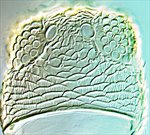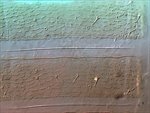
betae antenna

betae head

betae pro, meso & metanota

betae tergites VII-X

betae tergites V-VI

betae sternite VII
Generic diagnosis
Female macropterous. Head wider than long, reticulate with markings inside the reticles; maxillary palps 3-segmented; eyes with six weakly pigmented facets; ocellar setae I present; setae III between the posterior ocelli and shorter than diameter of an ocellus; four or five pairs of postocular setae. Antennae 8-segmented, segment I without paired dorso-apical setae, III and IV with short forked sense-cones, III–VI with prominent rows of microtrichia on both surfaces, VI constricted sharply to basal pedicel. Pronotum reticulate, all setae small; six pairs of posteromarginal setae. Mesonotum with anteromedian campaniform sensilla; median setal pair far from posterior margin. Metanotum reticulate, median setae small and behind anterior margin; campaniform sensilla present. Fore wing veins with setae small and widely spaced; clavus with four veinal and one discal setae; posteromarginal fringe cilia wavy. Prosternal ferna weakly divided; basantra membranous, without setae; prospinasternum broad and transverse. Mesosternum with sternopleural sutures complete; endofurca with spinula. Metasternal endofurca without spinula. Tarsi 2-segmented. Tergites reticulate, II–VIII with translucent craspedum, S1 setae small and not close together; IX with two pairs of campaniform sensilla, marginal setae stout and shorter than tergite length; X with complete split. Sternites II–VI with one to five irregularly arranged discal setae; craspeda absent; III–VII with three pairs of marginal setae, II with two pairs, S1 on VII arising in front of margin.
Male similar to female; tergite IX without stout setae medially; sternites III–VIII with small circular pore plate medially.
Biological data
Collected from various herbaceous plants, and reported to be a vector of a tospovirus on Polygonum spp. [Polygonaceae] in Italy (Ciuffo et al., 2010).
Distribution data
Recorded in Europe from northern Italy to Denmark and eastwards to Siberia (zur Strassen, 2003), and also from Inner Mongolia in China (Zhang et al., 2018).
Nomenclatural data
Dictyothrips Uzel, 1895: 157. Type species Dictyothrips betae Uzel, 1895, by monotypy.
Only one species is known in this genus (ThripsWiki, 2020), and this has been recorded from northern China.
betae Uzel, 1895: 158.
Relationship data
Thripidae sub-family Thripinae: this is a diverse group involving more than 230 genera. Dictyothrips is unusual amongst the 40 genera that comprise the Anaphothrips complex in that the only species has a craspedum on tergites II–VIII and a few discal setae medially on the sternites.
References
Ciuffo M, Mautino GC, Bosco L, Turina M & Tavella L (2010) Identification of Dictyothrips betae as the vector of Polygonum ring spot virus. Annals of Applied Biology 157: 299–307.
Masumoto M & Okajima S (2017) Anaphothrips genus-group: key to world genera, with two new species and three new records from Japan (Thysanoptera, Thripidae). Zootaxa 4272 (2): 201–220.
Zhang SM, Wang ZH, Li YJ & Mound LA (2018) One new species, two generic synonyms and eight new records of Thripidae from China (Thysanoptera). Zootaxa 4418 (4): 370–378.